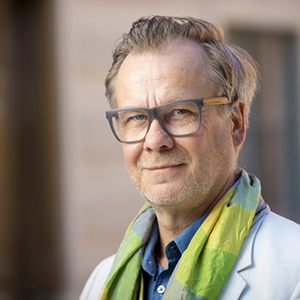The EU has issued a call for proposals for a Knowledge and Innovation Community (KIC) focusing on CCSI. Uppsala University is part of a consortium hoping to win the chance to run the KIC. But regardless of who gets to run it, grants will be announced by the KIC for CCSI projects that anyone can apply for.
“This will provide enormous opportunities, especially for education and research in the humanities and social sciences. It’s the biggest investment in culture in Europe, probably even the world, ever,” says Christer Gustafsson, professor at the Department of Art History.
An opportunity for HumSam
In short, one could summarise the upcoming KIC in the culture and creative sectors and industries as a way of making the most of public funds and deriving even more benefit from CCSI, including research and education.
 “We should see this as an opportunity and be curious about it. How can we understand our research as having potential for the culture–creativity–innovation nexus? How can we create new courses and study programmes? Innovation should not be interpreted as just a new product, but in a broader sense: how can we innovate to create the conditions for transitioning to a socially strong, democratic, digitalised and sustainable society? How can we, as researchers in the humanities and social sciences, contribute to this in innovative ways?”
“We should see this as an opportunity and be curious about it. How can we understand our research as having potential for the culture–creativity–innovation nexus? How can we create new courses and study programmes? Innovation should not be interpreted as just a new product, but in a broader sense: how can we innovate to create the conditions for transitioning to a socially strong, democratic, digitalised and sustainable society? How can we, as researchers in the humanities and social sciences, contribute to this in innovative ways?”
The decision to issue a call for a KIC in the culture and creative sectors and industries means that these sectors and industries are taking a step up and becoming an important player in the transition to a sustainable society.
“It’s not about all artistic and cultural activities needing to become financially profitable or pursuing a political agenda. It’s about us needing to understand the synergies in new ways because that’s how we can create new opportunities. CCSI today are an industrial ecosystem that the EU and the Swedish Government have decided to prioritise.”
Not always easy
But Christer Gustafsson also notes that it is not always easy to be a research or education partner in major European collaboration projects.
“We may not be entirely familiar with the rules of the game, traditions and decision pathways. But we can learn, and by taking the time to do so we will also strengthen research in other new partnerships and contexts.”
Christer Gustafsson describes how we researchers in the humanities and social sciences could perhaps learn from researchers in Uppsala University’s other two disciplinary domains, TEKNAT and MEDFARM.
“They generally tend to be better prepared to be responsive to this form of dialogue. But all research is enriched by discussion and input from people other than researchers. If you can promote your research in contexts other than the peer review process, that offers whole new opportunities for how your research can make a difference in the future.”
Innovation strongest within CCSI
Christer Gustafsson, along with an Italian colleague, wrote the documentation that led to the European Commission deciding to start up the new KIC focused on the culture and creative sectors and industries.
In writing this documentation, they chose to highlight and emphasise the culture–creativity–innovation nexus, because calls for all KICs are via the European Institute of Innovation and Technology. They therefore investigated what the research has to say about CCSI and the term innovation.
“Innovation is much broader than new technology. The research shows, for example, that the cultural industry has a greater capacity for innovation than other industries, and that the capacity for innovation in the cultural industry spills over into other industries.”
In Region Västra Götaland, for example, it can be seen that areas where cultural activities are strongest are also the areas with the most patents.
People who are culturally active acquire for themselves a greater understanding of, and openness and receptiveness to, innovation. As individuals, they are accustomed to viewing things, and looking at things in the world in general, in new ways. This of course benefits their ability to identify new approaches to things even outside the realm of culture.
It’s easy to see the connection between culture and creativity and innovation.
“But not everyone sees the entire chain from culture to innovation, and that culture plays an important role in innovation environments.”
CCSI twice the size of the automotive industry
In 2006, an EU report found that the culture and creative sectors and industries have twice the turnover of the automotive industry in Europe. In 2017, CCSI accounted for 4 per cent of the EU’s GDP.
Research shows that the most innovative countries are also the most culturally active and that CCSI have roughly twice the innovation capacity of other industries and even double the level of digital innovation.
“Theatre and cinema are just the tip of the iceberg in the culture and creative sectors and industries. There is so much more, such as how we tackle the democratic deficit and how we transition to a sustainable society.
The digital gaming industry of course is an important part of digital innovation within the CCSI. One example of how the innovation capacity in CCSI spills over into traditional industries is how the automotive industry has taken up ideas from digital games and implemented them to increase safety and make driving vehicles easier.
A concrete example of how CCSI are central to the transition to a sustainable society is Christer Gustafsson’s own research field, which is conservation.
“Today, conservation is about how to find new activities that can contribute everyday benefits and create jobs while preserving a valuable environment. As researchers, we must be involved early in the process and at a regional level. To be successful in this, we have had to engage with the regional innovation strategies and learn about how the European Structural Funds work to access new funding.”
CCSI are different to other industries
But CCSI are not like any other. They have significant differences when compared with other industries. These industries are knowledge-intensive, with a large proportion of solo entrepreneurs. There are also some CCSI where it is difficult to change production, for example, it may not be very effective for musicians to increase the speed of their playing, nor for actors to speak faster on the stage.
“Not everything can be counted in euros and cents. There are also changes happening in the CCSI, from enterprises to communities, and from passive customers to active participants who co-create their own cultural experiences.”
Will strengthen the whole university
By strengthening the work with CCSI in the Disciplinary Domain of Humanities and Social Sciences, Christer Gustafsson believes that the whole university will benefit.
“The innovation capacity within CCSI will also spill over within Uppsala University and strengthen both our capacity for innovation and cooperation between our disciplinary domains.”
